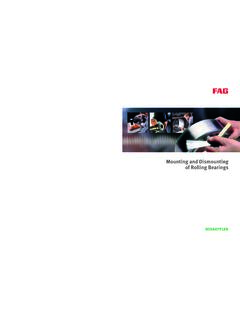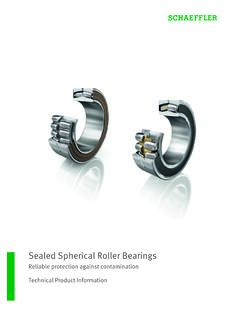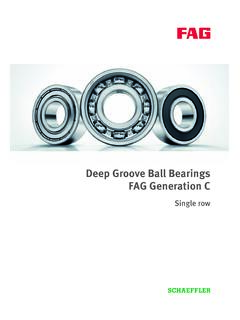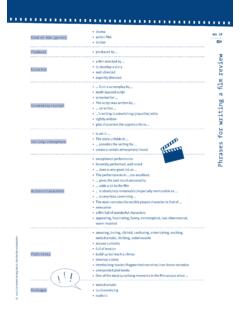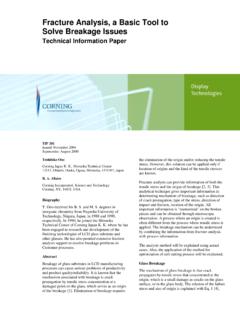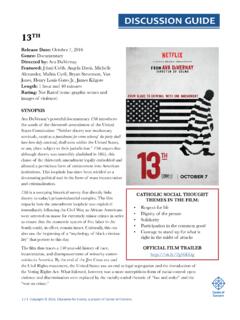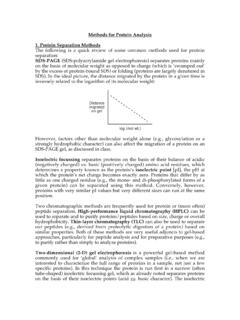Transcription of An Overview of Bearing Vibration Analysis - Schaeffler Group
1 An Overview of Bearing Vibration AnalysisDr. S. J. Lacey, Engineering Manager Schaeffler UK LimitedAn Overview of Bearing Vibration AnalysisDr. S. J. Lacey, Engineering Manager Schaeffler UK1. IntroductionRolling contact bearings are used in almost every type ofrotating machinery whose successful and reliable operation isvery dependent on the type of Bearing selected as well as theprecision of all associated components shaft, housing,spacers, nuts etc. Bearing engineers generally use fatigue asthe normal failure mode on the assumption that the bearingsare properly installed, operated and maintained. Today, becauseof improvements in manufacturing technology and materials, Bearing fatigue life, which is related to sub surface stresses, is generally not the limiting factor and probably accounts forless than 3% of failures in though, many bearings fail prematurely inservice because of contamination, poor lubrication,misalignment, temperature extremes, poor fitting/fits, shaftunbalance and misalignment.
2 All these factors lead to anincrease in Bearing Vibration and condition monitoring hasbeen used for many years to detect degrading bearings beforethey catastrophically fail, with the associated costs ofdowntime or significant damage to other parts of the element bearings are often used in noise sensitiveapplications household appliances, electric motors whichoften use small to medium size bearings. Bearing Vibration istherefore becoming increasingly important from both anenvironmental perspective and because it is synonymous withquality. It is now generally accepted that quiet running is synonymouswith the form and finish of the rolling contact surfaces. As aresult Bearing manufacturers have developed Vibration tests asan effective method for measuring quality. A commonapproach is to mount the Bearing on a quiet running spindleand measure the radial velocity at a point on the Bearing souter ring in three frequency bands, 50-300, 300-1800 and1800-10000Hz. The Bearing must meet RMS velocity limits inall three frequency monitoring has now become a well accepted part ofmany planned maintenance regimes and relies on the wellknown characteristic Vibration signatures which rollingbearings exhibit as the rolling surfaces degrade.
3 However, inmost situations Bearing Vibration cannot be measured directlyand so the Bearing Vibration signature is modified by themachine structure and this situation is further complicated byvibration from other equipment on the machine electricmotors, gears, belts, hydraulics, etc. and from structuralresonances. This often makes the interpretation of vibrationdata difficult other than by a trained specialist and can in somesituations lead to a misdiagnosis resulting in unnecessarymachine downtime and this article the sources of Bearing Vibration are discussedalong with the characteristic Vibration frequencies that arelikely to be Sources of VibrationRolling contact bearings represent a complex Vibration systemwhose components rolling elements, inner raceway, outerraceway and cage interact to generate complex vibrationsignatures. Although rolling bearings are manufactured usinghigh precision machine tools and under strict cleanliness andquality controls, like any other manufactured part they will havedegrees of imperfection and generate Vibration as thesurfaces interact through a combination of rolling and , although the amplitudes of surface imperfectionsare in the order of nanometres, significant vibrations can stillbe produced in the entire audible frequency range (20Hz - 20kHz).
4 The level of the Vibration will depend upon many factorsincluding the energy of the impact, the point at which thevibration is measured and the construction of the produced by rolling bearings can be complex and can result from geometrical imperfectionsduring the manufacturing process, defects on the rolling surfaces or geometrical errors in associatedcomponents. Noise and Vibration is becoming more critical in all types of equipment since it is oftenperceived to be synonymous with quality and often used for predictive maintenance. In this article thedifferent sources of Bearing Vibration are considered along with some of the characteristic defectfrequencies that may be present. Some examples of how Vibration Analysis can be used to detectdeterioration in machine condition are also Variable ComplianceUnder radial and misaligned loads Bearing Vibration is aninherent feature of rolling bearings even if the Bearing isgeometrically perfect and is not therefore indicative of poorquality.
5 This type of Vibration is often referred to as variablecompliance and occurs because the external load is supportedby a discrete number of rolling elements whose position withrespect to the line of action of the load continually changeswith time, Figure 1. Fig 1. Simple Bearing modelAs the Bearing rotates, individual ball loads, hence elasticdeflections at the rolling element raceway contacts, change toproduce relative movement between the inner and outer movement takes the form of a locus which under radialload is two dimensional and contained in a radial plane whilstunder misalignment it is three dimensional. The movement isalso periodic with base frequency equal to the rate at whichthe rolling elements pass through the load zone. Frequencyanalysis of the movement yields the base frequency and aseries of harmonics. For a single row radial ball Bearing withan inner ring speed of 1800rev/min a typical ball pass rate is100Hz and significant harmonics to more than 500Hz can compliance Vibration is heavily dependent on thenumber of rolling elements supporting the externally appliedload; the greater the number of loaded rolling elements, theless the Vibration .
6 For radially loaded or misaligned bearings running clearance determines the extent of the load region,and hence, in general variable compliance increases withclearance. Running clearance should not be confused withradial internal clearance (RIC), the former normally being lowerthan the RIC due to interference fit of the rings anddifferential thermal expansion of the inner and outer ringsduring compliance Vibration levels can be higher than thoseproduced by roughness and waviness of the rolling surfaces,however, in applications where Vibration is critical it can bereduced to a negligible level by using ball bearings with thecorrect level of axial Geometrical ImperfectionsBecause of the very nature of the manufacturing processesused to produce Bearing components geometricalimperfections will always be present to varying degreesdepending on the accuracy class of the Bearing . For axiallyloaded ball bearings operating under moderate speeds theform and surface finish of the critical rolling surfaces aregenerally the largest source of noise and component waviness and surface finish during themanufacturing process is therefore critical since it may notonly have a significant effect on Vibration but also may affectbearing is convenient to consider geometrical imperfections in termsof wavelength compared with the width of the rolling element-raceway contacts.
7 Surface features of wavelength of the orderof the contact width or less are termed roughness whereaslonger wavelength features are termed waviness, Figure 2. Waviness and roughness of rolling Surface RoughnessSurface roughness is a significant source of Vibration when itslevel is high compared with the lubricant film thicknessgenerated between the rolling element-raceway contacts(Figure 2). Under this condition surface asperities can breakthrough the lubricant film and interact with the opposingsurface, resulting in metal-to-metal contact. The resultingvibration consists of a random sequence of small impulseswhich excite all the natural modes of the Bearing andsupporting roughness produces Vibration predominantly atfrequencies above 60 times the rotational speed of thebearing, thus the high frequency part of the spectrum usuallyappears as a series of 3A common parameter used to estimate the degree of asperityinteraction is the lambda ratio ( ). This is the ratio of lubricantfilm thickness to composite surface roughness and is given by: = h ( b2+ r2) = degree of asperity interactionh= the lubricant film thickness b= RMS roughness of the ball r= RMS roughness of the racewayIf we assume that the surface finish of the raceway is twicethat of the rolling element, then for a typical lubricant filmthickness of 0,3 m surface finishes better than 0,06 m arerequired to achieve a value of three and a low incidence ofasperity interaction.
8 For a lubricant film thickness of 0,1 msurface finishes better than 0,025 m are required to achieve = 3. The effect of on Bearing life is shown in Figure 3 (1).Fig 3. Percent film versus (function of film thickness and surface roughness).If is less than unity it is unlikely that the Bearing will attainits estimated design life because of surface distress which canlead to a rapid fatigue failure of the rolling surfaces. In general ratios greater than three indicate complete surfaceseparation. A transition from full EHL (elastohydrodynamiclubrication) to mixed lubrication (partial EHL film with someasperity contact) occurs in the range between 1 and WavinessFor longer wavelength surface features, peak curvatures arelow compared with that of the Hertzian contacts and rollingmotion is continuous with the rolling elements following thesurface contours. The relationship between surface geometryand Vibration level is complex being dependent upon thebearing and contact geometry as well as conditions of loadand speed.
9 Waviness can produce Vibration at frequencies upto approximately 300 times rotational speed but is usuallypredominant at frequencies below 60 times rotational upper limit is attributed to the finite area of the rollingelement raceway contacts which average out the shorterwavelength the direction of rolling, elastic deformation at the contactattenuates simple harmonic waveforms over the contact width,Figure 4. Figure 4. Attenuation due to contact widthThe level of attenuation increases as wavelength decreasesuntil, at a wavelength equal to the contact width, wavinessamplitude is theoretically zero. The contact length alsoattenuates short wavelength surface features. Generally poorcorrelation can exist between parallel surface height profilestaken at different points across the tracks and this averagesmeasured waviness amplitudes to a low level. For typicalbearing surfaces poor correlation of parallel surface heightsprofiles only exists at shorter with modern precision machining technology wavinesscannot be eliminated completely and an element of wavinesswill always exist albeit at relatively low levels.
10 As well as thebearing itself the quality of the associated components canalso affect Bearing Vibration and any geometrical errors on theoutside diameter of the shaft or bore of the housing can bereflected on the Bearing raceways with the associatedincrease in Vibration . Therefore, careful attention is required tothe form and precision of all associated Bearing components. Discrete DefectsWhereas surface roughness and waviness result directly fromthe Bearing component manufacturing processes, discretedefects refers to damage of the rolling surfaces due toassembly, contamination, operation, mounting, poormaintenance etc. These defects can be extremely small anddifficult to detect and yet can have a significant impact onvibration critical equipment or can result in reduced bearinglife. This type of defect can take a variety of forms:indentations, scratches along and across the rolling surfaces,pits, debris and particles in the lubricant. Bearing manufacturers have adopted simple vibrationmeasurements on the finished product to detect such defectsbut these tend to be limited by the type and size of example of this type of measurement is shown in Figure 5, Page 4where compared to a good Bearing , the discrete damage on abearing outer ring raceway has produced a characteristicallyimpulsive Vibration which has a high peak/RMS ratio.






